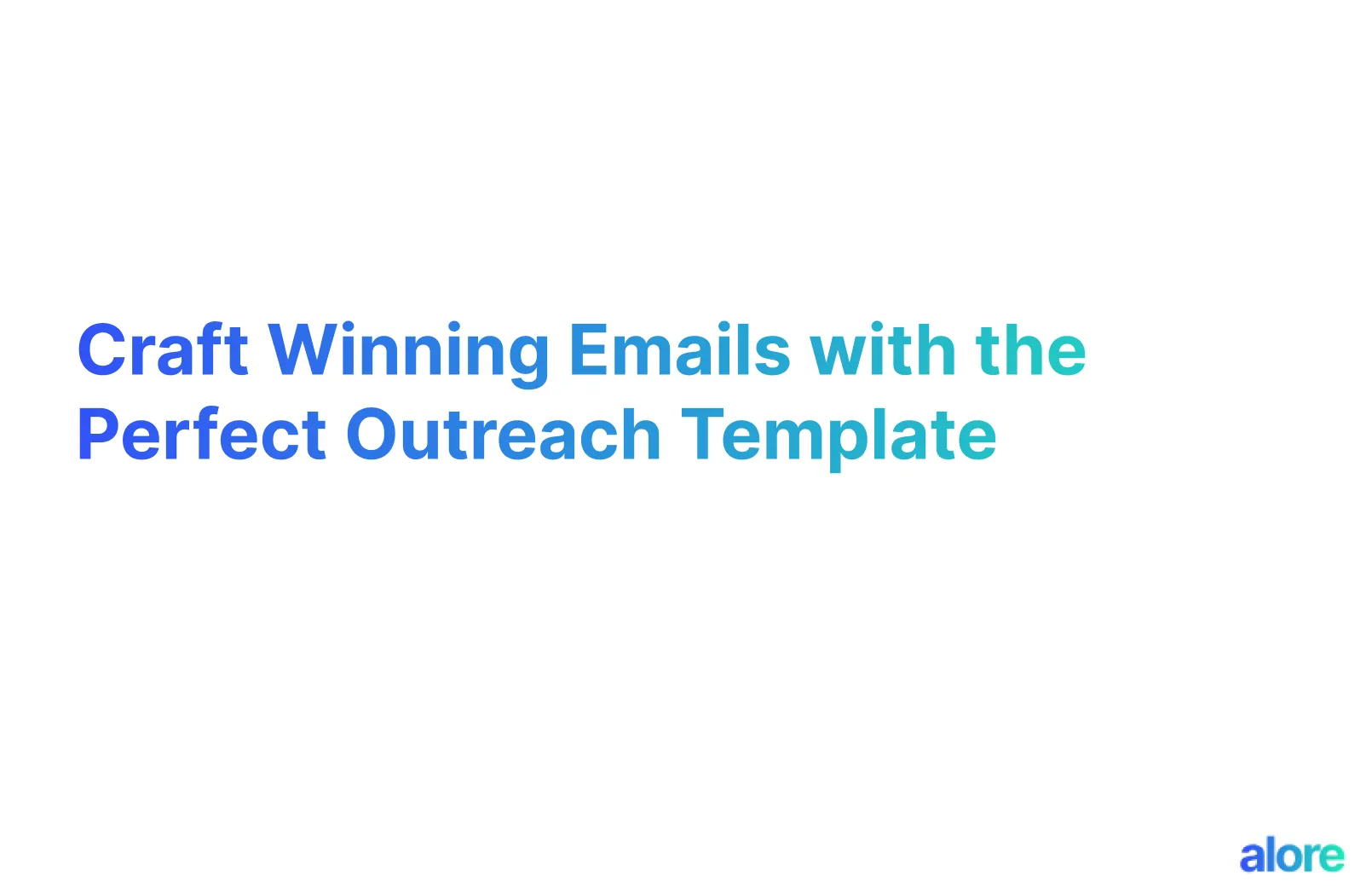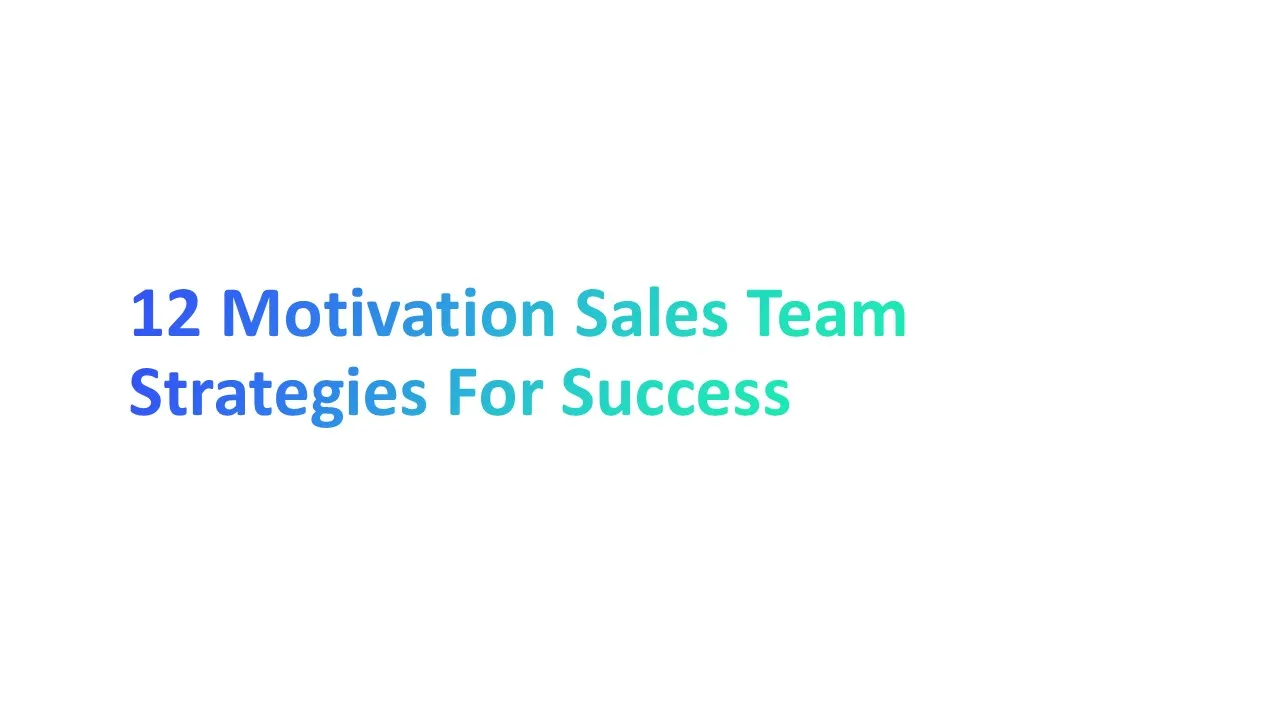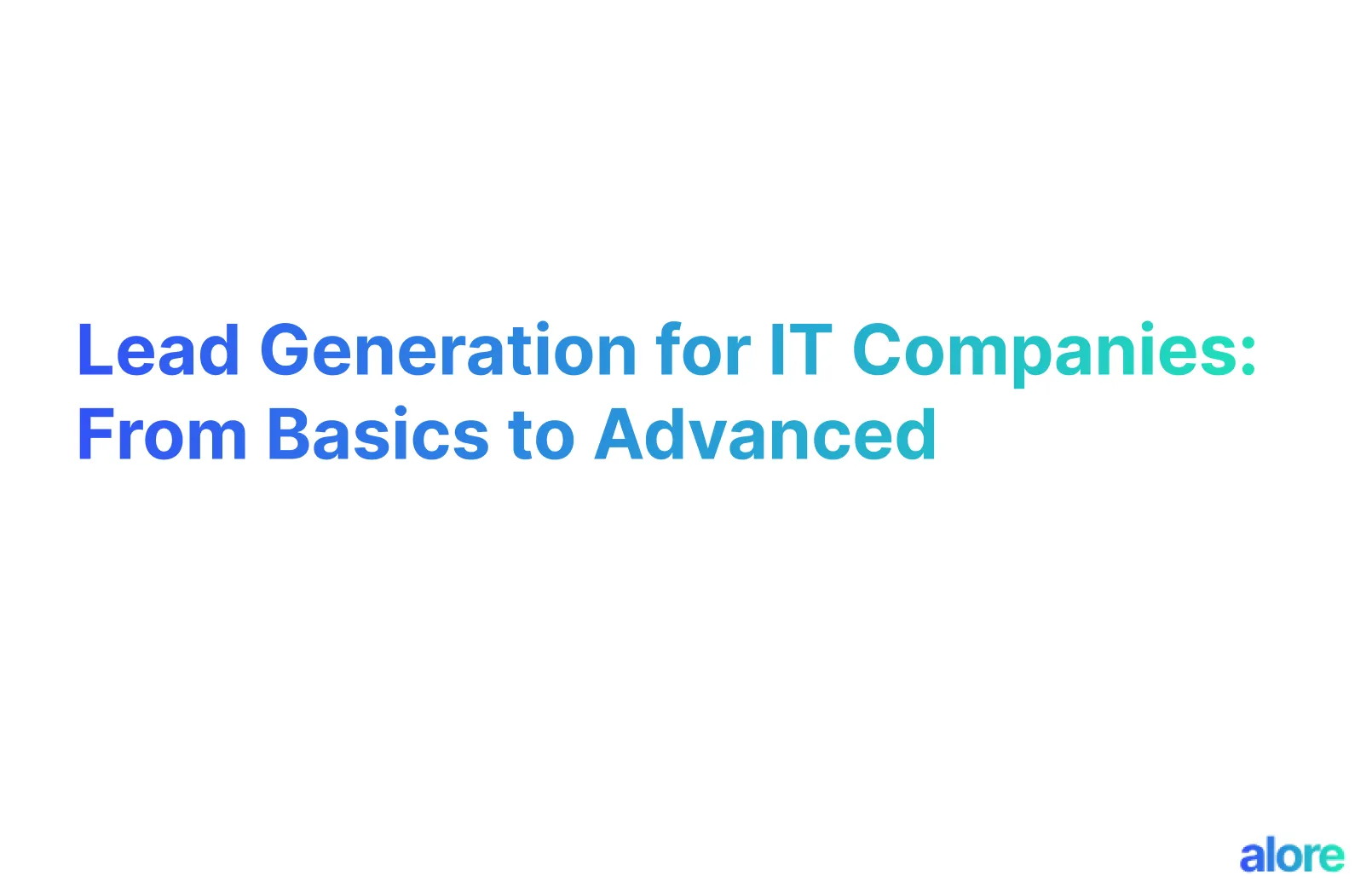Introduction to Outreach Template
Why You Need Outreach Templates
In today's dynamic business environment, efficiency and effectiveness are key, making outreach templates an essential tool.
They serve multiple purposes:
Streamlining Communication:
Instead of crafting individual messages, templates offer a time-saving solution crucial in managing large volumes of outreach, such as cold emails or follow-ups.
Ensuring Consistency
For businesses, especially those in link-building or influencer marketing, maintaining a consistent voice in communication is vital. Templates help preserve this uniformity across various platforms and interactions.
Enhancing Response Rates
A well-designed template, personalized for different scenarios like accepting guest posts or engaging potential clients, can significantly improve the likelihood of receiving positive responses.
The Role of Outreach in Business Outcomes
Effective outreach is a strategic component in driving business growth.
Its impact spans several key areas:
Lead Generation
Targeted outreach, especially to specific job titles or market segments, is instrumental in generating new leads.
Brand Awareness
Regular, well-crafted outreach keeps your brand visible and top-of-mind among your target audience and potential customers.
Partnership Opportunities
Reaching out to potential collaborators or those accepting guest posts paves the way for beneficial partnerships and expanded reach.
How to Create Brand Outreach Templates
Developing a compelling brand outreach template involves a thoughtful process tailored to your audience's preferences and your campaign goals:
Audience Analysis
Understanding your target audience, whether it's for a product launch, link building, or influencer marketing, is the first step. This involves considering factors like their interests, challenges, and the type of content they value.
Identifying Pain Points
Recognizing and addressing the specific pain points of your audience is essential. This demonstrates empathy and positions your product or service as a potential solution to their problems.
Crafting Engaging Subject Lines
The subject line is your first impression. It should be intriguing and relevant, capable of piquing interest amidst a sea of emails.
Personalization and Relevance
Incorporating elements like the recipient’s name or a reference to a recent article they published adds a personal touch to your template, making it more engaging.
Clear and Compelling Call-to-Action (CTA)
Your CTA should guide recipients on the next steps, whether it’s visiting a landing page, exploring a resource page, or setting up a brief call.
Continuous Improvement
Use feedback and data from email outreach software to refine your templates. Analyzing what resonates with your audience can lead to more effective email outreach template strategies.
Follow-Up Strategies
Incorporate templates for follow-up emails. Persistence, when done respectfully, can significantly increase your outreach success rate.
Incorporating Visual Elements
Sometimes, visuals like infographics or charts can enhance the effectiveness of your outreach, especially when explaining complex concepts or showcasing data.
Legal Compliance and Ethical Considerations
Ensure that your outreach and outreach email templates comply with legal standards like GDPR for email communication and respect ethical boundaries.
How to Create Impactful Email Outreach Templates
Email outreach, a cornerstone in digital marketing strategies like cold emailing, link building, and influencer marketing, demands a nuanced approach.
Key principles include:
Understanding the Target Audience
Deep knowledge of your audience, from their job titles to industry-specific challenges, is crucial. This insight is vital for crafting resonating messages, particularly when discussing new business trends or addressing pain points.
Clarity and Precision
The objective of your email should be unmistakable. A straightforward, concise message respects the recipient's time and improves engagement.
Personalization
This goes beyond using the recipient's name. Tailoring the content to reference their recent articles, mutual connections, or expressing honest feedback creates a genuine connection.
Presenting a Clear Value Proposition
Each email should articulate the value it brings, whether offering a solution, a resource link, or a chance for collaboration.
Designing Templates for Maximum Engagement: Step-by-Step Guide
To ensure your email outreach templates are effective, follow this detailed guide:
Audience Research and Segmentation: Start by dividing your audience based on factors like industry, job title, and known challenges. This segmentation enables you to create messages that cater to specific groups, enhancing relevance.
Crafting an Engaging Subject Line: Your subject line is your first chance to catch attention. It should be intriguing, possibly including a call-to-action or alluding to the content, like a brief mention of a resource page or an upcoming blog post.
Creating the Email Body:
- Introduction: Begin with a friendly greeting. If you share a mutual connection or if you're addressing them about a recent article or blog post, mention it here.
- Main Content: State the purpose of your email clearly. Discuss how your product or service can solve their problems, or invite them to contribute a guest post. Address common pain points directly. Insert key takeaway that would help them decide if they want to invest time.
- Call-to-Action: Conclude with a precise CTA, be it a request for a brief call, a visit to a landing page, or expressing interest in a guest post or link-building opportunity.
Incorporating Visuals and Links: Add visuals or links to a resource page where relevant. These elements can make your email more engaging and informative.
Feedback-Driven Optimization Utilize insights from email outreach software to refine your templates continuously. This might involve adjusting the subject lines, CTAs, or content based on how recipients are engaging with your emails.
Legal and Ethical Compliance
Ensure all your emails comply with legal standards like GDPR, especially when sending cold emails or outreach emails.
Testing and Iteration
Regularly test different versions of your email templates. This includes experimenting with different subject lines, such as those that pose a question or offer a quick solution, to see which performs best.
Follow-Up Strategy
Develop a strategy for follow-up emails. This could include a series of emails that gradually build on the initial message, keeping your audience engaged without being intrusive.
Educational Content
Occasionally include educational content like tips on email outreach, insights into current market trends, or ways to improve their own outreach strategies. This adds value to your emails, positioning you as a credible source of information.
Collaborative Invitations
Extend invitations for collaborations, such as joint webinars, guest post outreach email exchanges, or mutual link-building efforts. These offers can foster long-term professional relationships.
How to Create Template for Successful Link Building
Advanced Techniques in Link-Building Email Templates
Link building emails, an integral part of SEO strategy, demand a nuanced and targeted approach to email outreach.
To craft successful link-building email templates, consider these advanced techniques:
Personalized Outreach
Go beyond the basics. Research the recipient's recent articles or blog posts, understand their content and writing style, and refer to these elements in your email.
Personalization shows that you're not just sending a generic request but are genuinely interested in their content. Use the company name or his job title to personalize.
Clear Value Proposition
Explain how your link adds value to their page. Whether it's a resource page link, an insightful blog post, or a unique study, make it clear why your content benefits them and their audience.
Short and Engaging Subject Lines:
Craft subject lines that capture attention. Phrases like "Quick Request for [Their Blog Name]" or "Suggestion for Your Resource Page" are direct and informative.
Concise and Direct Content
Keep your email body concise. Introduce yourself, explain your request, and why you believe the link addition would be mutually beneficial. Avoid lengthy introductions.
Use of Data and Examples
Include data or examples to support your request. Mentioning the success of your content or how it complements their existing resources can be persuasive.
Follow-Up Strategy
Plan a respectful follow-up strategy. A gentle reminder highlighting the mutual benefits can be effective if you don't hear back.
Resource Page Optimization and Link Reclamation
In link building, optimizing resource pages and reclaiming broken links are crucial strategies:
Identifying Potential Resource Pages
Use tools to find relevant websites with resource pages in your niche. Craft personalized emails to these site owners, suggesting your content as a valuable addition to their resources.
Broken Link Strategy
Identify broken links on relevant websites using SEO tools.
In your outreach email, point out the broken link and suggest your content as a suitable replacement.
This approach provides value to the site owner with a broken link URL or Post URL and positions your link as a helpful solution.
Demonstrating Credibility and Relevance
When suggesting your content, highlight its relevance and credibility—share metrics, user engagement data, or how your content has benefited similar websites.
Crafting a Mutually Beneficial Proposal
Make your proposal mutually beneficial. Offer to share their content on your platform or propose a collaborative blog post or webinar.
Maintaining Professionalism and Persistence
Always maintain a professional tone, even if you don't get an immediate response. Persistence is key, but it should be balanced with respect for the recipient's time and inbox.
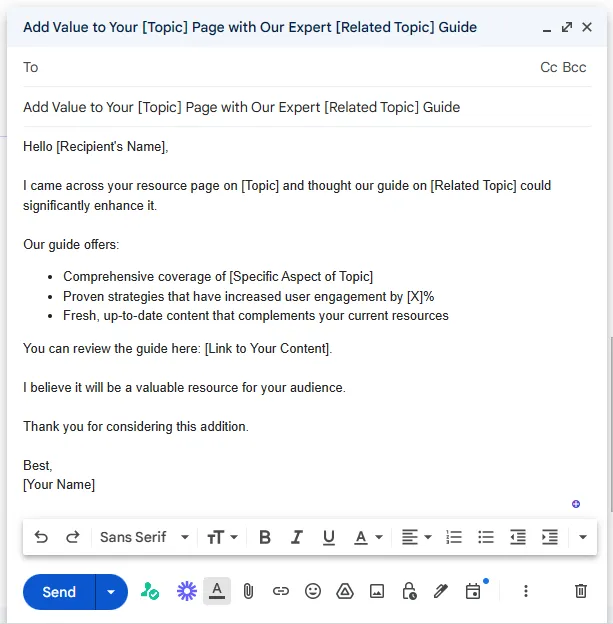

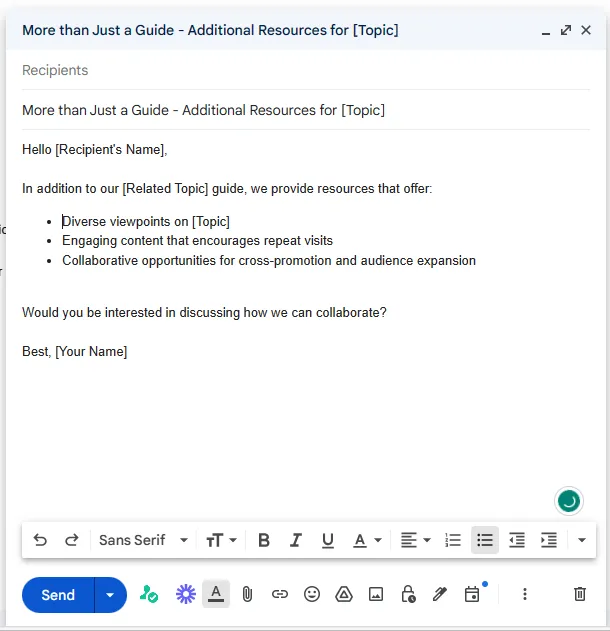

Template for Guest Posts
Innovative Guest Post Strategies
The key to success lies in adopting strategies that align with your objectives and resonate with the host site's audience.
It involves understanding their content landscape, aligning your message with their themes, and adding value through your unique insights or expertise.
Effective guest posting is a blend of art and science - it's about crafting content that is both informative and engaging, ensuring it speaks directly to the readers’ interests and needs.
Choosing the Right Platforms
Look for websites that align with your content's theme, focusing on those with high traffic and engagement.
Understanding Audience Interests
Analyze social media trends and recent articles to gauge the audience's interests. Tailor your posts to these insights.
Integrating SEO
Incorporate relevant keywords such as 'guest post', 'link building', and 'blog post' to enhance search engine visibility.
Engaging Content Design
Include visuals like infographics in your posts to make them more appealing and shareable.
Credible and Informative Writing
Ensure your guest posts and web team are well-researched, offering valuable information clearly and authoritatively.


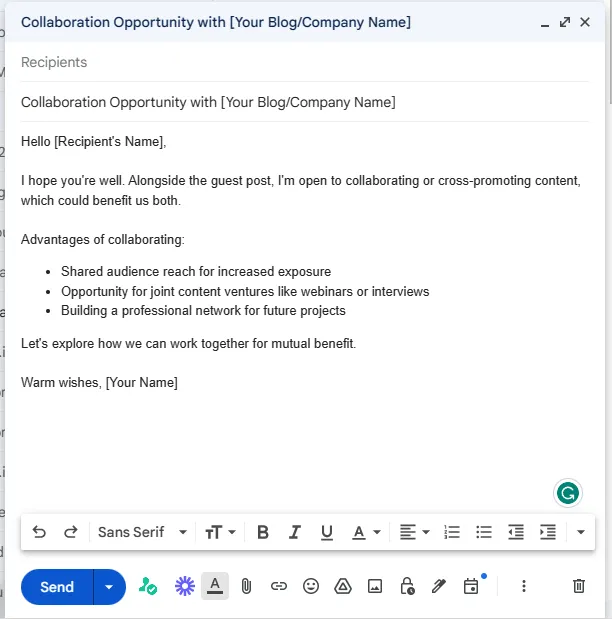
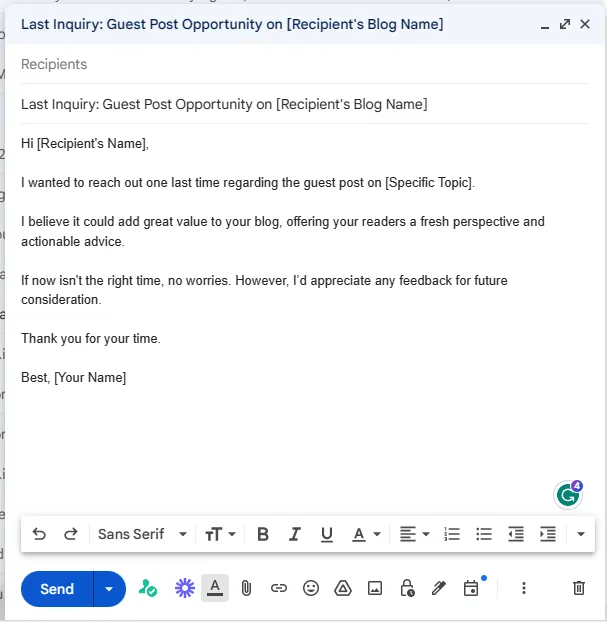
How to Effectively Promote Blog via Email Outreach
A well-planned email campaign can significantly increase the visibility and reach of your blog posts.
It involves crafting messages that capture the essence of your post and demonstrate its value to your recipients.
The goal is to entice them to read and share your content within their networks.
To achieve this, you need to be thoughtful about every aspect of your email - from the subject line to the call-to-action, ensuring that each element is designed to grab attention and encourage engagement.
Personalized Email Templates
Create adaptable outreach templates that can be customized for each recipient, highlighting mutual interests or recent articles.
Clear Call-to-Action
Directly encourage recipients to read and share your post, clearly stating the action you desire.
Follow-Up Strategies
Utilize follow-up email templates for non-responsive recipients, keeping the message brief yet persuasive.
Showcasing the Benefits
Articulate the advantages of your blog post, focusing on how it addresses relevant topics or questions.
Networking and Building Connections
Use email outreach to foster relationships, offering to feature their content on your platform.
Template for Cold Emailing for Brief Call
Creating effective cold emails for a brief call involves crafting messages that are persuasive, clear, and targeted towards your recipient's needs and interests. Here’s how to approach this:
Crafting Persuasive Cold Email Templates
1. Start with a Strong Opening: Begin with a compelling opening that grabs attention. Mention something relevant to the recipient, like a recent company milestone or an industry trend.
2. Introduce Yourself and Your Purpose: Clearly introduce yourself and the purpose of your email. Keep it concise and to the point, focusing on the reason for the requested brief call.
3. Articulate Value Proposition: Explain how your product or service can benefit the recipient. Highlight key features or advantages that are most likely to resonate with them.
4. Personalize the Message: Tailor the email to show that you have done your research. Personalization can include mentioning specific challenges or goals of the recipient's company.
5. Strong Call to Action: Encourage the recipient to take action, such as agreeing to a brief call. Be clear about what you wish to discuss during the call.
6. Provide Contact Information: Include your contact details, making it easy for them to reach out to you.
Techniques for New Business Acquisition Through Cold Emails
1. Target the Right Audience: Ensure that your cold email list consists of individuals or businesses that are likely to benefit from your offer. This targeting increases the chance of a positive response.
2. Highlight Benefits Over Features: Focus on how your service or product can solve problems or improve the recipient's situation, rather than just listing features.
3. Use Social Proof: Mention any significant clients, awards, or testimonials you have that can add credibility to your proposition.
4. Keep it Short and Engaging: Your email should be concise yet engaging enough to pique interest. Long emails are often ignored.
5. Follow-Up Strategy: Have a plan for following up on your initial email. A well-timed follow-up can significantly increase your chances of getting a response.
6. A/B Testing: Experiment with different email formats, subject lines, and content to see which works best for your audience.
How to Write Follow-Up Template: Ensuring Outreach Success
Crafting Compelling Follow-Up Emails
Effective follow-up emails are pivotal in successful outreach campaigns. They keep your proposal at the forefront without overwhelming the recipient.
Whether it's a cold email for sales outreach, a guest post invitation, or a product pitch, these emails should tactfully remind and persuade.
Initial Outreach Recap
Reiterate the core message of your initial outreach. If it was about a guest post, recap the proposed topic's relevance to their audience. For sales outreach, remind them briefly of the key benefits of your product or service.
Personalization and Connection
Use their name, refer to a recent article, make personalized comment they've written, or a mutual connection to personalize the message. This approach fosters a sense of familiarity and consideration.
Benefits and Value Addition
Emphasize how your proposal can add value, like a guest post or a new business collaboration. Mention specific pain points it addresses or unique insights it offers.
Call to Action Reinforcement
Encourage them to take the next step – whether it's reading a detailed blog post, reviewing a sales outreach email template, or exploring a partnership opportunity.
Strategies for Persistent yet Respectful Follow-Ups
The art of follow-up lies in being persistent without being a nuisance. It's about striking the right chord at the right time.
Timing is Key
Space out your follow-ups strategically. A good rule of thumb is to wait for about a week after your initial email and then a few days more after each subsequent follow-up.
New Information or Angles
In each follow-up, try to bring something new to the table. For instance, update them on a recent development related to your proposal or offer a new perspective on your initial pitch.
Respecting Their Time
Acknowledge that they might be busy. Phrases like, “I understand you have a busy schedule” show empathy and respect for their time.
Option to Decline or Opt-Out
Politely give them an option to opt out of further communication. This respects their decision and leaves a door open for future interactions.
Customized Email Templates for Various Business Scenarios
Cold Sales Outreach and Customer Engagement Templates
In cold sales outreach, the key is to strike a balance between being informative and not overly aggressive.
Certain elements are crucial for effectiveness and response rate when creating templates for cold sales outreach and customer engagement. Here's a list of what should matter:
1. Clear and Concise Introduction:
- Cold Sales: Briefly introduce yourself and your company.
- Customer Engagement: Acknowledge the customer’s previous interaction with your company.
2. Value Proposition:
- Cold Sales: Clearly articulate how your product or service can benefit the recipient.
- Customer Engagement: Highlight the benefits of continued engagement or new features of your product/service.
3. Personalization:
- Both: Tailor the email to address the recipient’s specific business needs, interests, or past interactions.
4. Strong Subject Line:
- Cold Sales: Create a compelling subject line that encourages the recipient to open the email.
- Customer Engagement: Use a familiar and friendly tone that resonates with existing customers.
5. Call to Action (CTA):
- Cold Sales: Include a specific CTA, like scheduling a call or a demo.
- Customer Engagement: Encourage them to explore a new product, provide feedback, or take advantage of a special offer.
6. Social Proof or Testimonials:
- Cold Sales: Mention successful case studies, testimonials, or well-known clients to build credibility.
- Customer Engagement: Share stories or testimonials of other customers who benefited from continued engagement.
7. Brief and to the Point:
- Both: Keep the email concise and focused, avoiding unnecessary details.
8. Professional Tone with a Touch of Warmth:
- Cold Sales: Be professional yet approachable.
- Customer Engagement: Use a more familiar tone, reflecting an existing relationship.
9. Contact Information:
- Both: Ensure your contact details are easily accessible for them to respond.
10. Follow-Up Strategy:
- Cold Sales: Plan for a follow-up email if there is no response.
- Customer Engagement: Provide an easy way for customers to reach out with questions or for more information.
Cold Sales email template that helped us reach US$ 1M ARR
Reaching the milestone of US$ 1M in Annual Recurring Revenue is a testament to the power of well-crafted cold sales email strategies. Alore utilized a series of tailored email templates meticulously designed to engage potential clients effectively.
These emails, characterized by their clear value proposition, personalized approach, and compelling call-to-actions, resonated deeply with their target audience. B
y aligning their solution with each prospect's unique needs and pain points, Alore was able to convert initial cold contacts into lucrative, long-term relationships, thereby driving significant revenue growth and achieving this impressive financial milestone.
Problem-Solving and Congratulatory Email Strategies
Certain elements are essential to ensure effectiveness and appropriate tone when crafting email templates for problem-solving and sending congratulatory messages.
Here are the key components to consider, aligning with the provided keyword list:
1. Acknowledgment of the Situation or Achievement:
Problem-Solving: Recognize the specific challenge or issue the recipient is facing.
Congratulatory: Clearly acknowledge the specific achievement or milestone.
2. Personalization and Relevance:
Both: Tailor the email to address the recipient's specific situation, using details like the recipient’s name, the specific problem or achievement, and relevant context.
3. Empathetic and Positive Tone:
Problem-Solving: Use an empathetic tone that shows understanding and willingness to help.
Congratulatory: Maintain an enthusiastic and celebratory tone.
4. Offering Assistance or Solutions:
Problem-Solving: Provide a concrete solution, advice, or offer assistance, possibly involving your product or service.
5. Encouraging Further Communication:
Include a call to action encouraging further dialogue, such as a follow-up meeting, a quick call, or a response email.
6. Use of Social Proof or Testimonials (if applicable):
Problem-Solving: Incorporate brief examples or testimonials where your product or service successfully addressed similar issues.
7. Clear and Concise Messaging:
Ensure the email is direct and to the point, avoiding overly complex language or jargon.
8. Professional Yet Approachable Tone:
Balance professionalism with a friendly tone to build rapport.
9. Contact Information:
Include your contact details for easy follow-up.
10. Follow-Up Strategy:
Problem-Solving: Mention how and when you will follow up if you don’t hear back.
Congratulatory: Suggest a future touchpoint to celebrate or discuss collaborative opportunities.
Influencer Marketing Outreach: Crafting Tailored Emails for Influencer Engagement
Influencer marketing outreach requires a personalized approach that respects the influencer's time and aligns with their interests. Here's how to craft effective influencer engagement emails, incorporating relevant keywords from the provided list:
1. Personalized Introduction:
Acknowledge the influencer’s work, referencing specific content (like a "recent article" or "latest podcast episode") that resonates with your brand’s mission or campaign.
2. Clear Purpose and Relevance:
State the purpose of your outreach clearly, highlighting why you chose them specifically and how their style or audience ("same audience") aligns with your brand.
3. Offer Value:
Explain what’s in it for them. This could be in terms of monetary compensation, free samples, or other mutually beneficial arrangements.
4. Tailored Proposal:
Propose a collaboration idea that is tailored to their content style and audience. Be specific about what you envision, whether it’s a product review, a sponsored post, or co-created content.
5. Flexibility and Openness:
Show that you’re open to their creative input and willing to collaborate on executing the campaign.
6. Call to Action:
Include a clear CTA, like inviting them for a "quick call" to discuss the collaboration further or asking them to reply with their thoughts or terms.
7. Professional Tone with a Personal Touch:
While remaining professional, use a tone that matches the influencer's style, indicating that you’re familiar with their work.
8. Contact Information:
Provide your contact details, making it easy for them to reach out to you.
9. Appreciation and Respect for Their Time:
Acknowledge that they’re busy and express appreciation for considering your proposal. Phrases like "a few minutes of your time" can be effective here.
10. Follow-Up Plan:
Mention that you’ll follow up if you don’t hear back within a certain timeframe, but ensure this is done respectfully.
Latest Podcast Promotions: Leveraging Podcasts in Outreach Strategies
Promoting your latest podcast effectively through email outreach involves a combination of personalization, clear messaging, and strategic use of keywords.
Here’s a guide to crafting these emails, ensuring optimal use of the provided keyword list:
1. Personalized Introduction:
Start with a personalized greeting. Reference the recipient's "recent article" or any specific content they have created, showing that you’ve done your homework.
2. Highlight the Podcast’s Unique Appeal:
Clearly state the unique selling point of your podcast. Mention a specific episode, perhaps the "latest podcast episode," and its key takeaways or guest speakers.
3. Align with Recipient’s Interests:
Tailor the content of your email to align with the recipient's interests or industry. If your podcast covers topics that resonate with their "target audience," make sure to highlight this.
4. Clear Call to Action:
Include a straightforward CTA, such as inviting them to listen to a specific episode, provide feedback, or even collaborate on a future episode.
5. Offer Value:
If possible, offer something of value like a "free sample" of a product mentioned in your podcast or exclusive access to additional content.
6. Use Engaging Subject Lines:
Craft subject lines that are intriguing and relevant. For example, "New Insights on [Topic] in Our Latest Podcast – A Must-Listen for [Their Profession/Interest]!"
7. Showcase Social Proof:
If your podcast has notable achievements, like a high number of downloads or featured expert guests, mention these as social proof.
8. Encourage Sharing and Engagement:
Ask the recipient to share the podcast with their network if they find it valuable, leveraging their "mutual connections" and "same audience."
9. Respectful Follow-Up:
Indicate that you’ll follow up if you don’t hear back, respecting their time. Use phrases like "a few minutes of your time" to acknowledge their busy schedule.
10. Contact Information:
Make sure your contact information is clearly stated for any further inquiries or potential collaborations.
Building on Mutual Connections: Emails That Leverage Shared Contacts
In the art of crafting emails that build upon mutual connections, it's essential to strategically incorporate relevant keywords while maintaining a natural and engaging flow. Here's how you can effectively write these emails:
1. Start with a Reference to the Mutual Connection
Begin your email by mentioning the mutual connection, emphasizing how you know them or how they recommended the recipient. For instance, "I was speaking with [Mutual Connection's Name], who suggested I reach out to you..."
2. Personalized Introduction
Introduce yourself and briefly explain your connection to the mutual contact. This could include mentioning a joint project or event where you both were involved, like "We collaborated on [Project/Event] with [Mutual Connection's Name]..."
3. Mention a Relevant Pain Point or Interest
Identify a common challenge or interest that aligns with the recipient's work or your mutual connection’s recommendation. For example, "I understand from [Mutual Connection's Name] that you are exploring solutions in [Area/Industry]..."
4. Offer a Solution or Opportunity
Propose how your service, product, or expertise can address their pain point or interest. Tailor this proposal to be as relevant and appealing as possible, like "I believe our [Product/Service] can offer a unique solution to the challenge of [Specific Issue] you’re facing..."
5. Highlight the Benefits of Collaboration
Elaborate on the advantages of working together. This could be in terms of shared goals, mutual benefits, or how your collaboration can lead to significant improvements or success in their field.
6. Include a Clear Call to Action
Encourage a specific action, such as a follow-up email, scheduling a quick call, or setting up a meeting to discuss potential collaboration opportunities.
7. Express Gratitude and Openness for Dialogue
Thank the recipient for considering your proposal and express your willingness to engage in a discussion, whether it's through a reply to the email or on a scheduled call.
8. Close with a Professional Sign-off
Conclude your email with a professional yet friendly sign-off, reinforcing your enthusiasm for potential collaboration.
9. Provide Your Contact Information
Ensure your contact details are included, making it easy for them to reach out to you directly for further discussion or clarification.
Engaging with Recent Articles: Templates for Thoughtful Content-Based Outreach
Crafting emails that engage recipients based on their recent articles requires a thoughtful approach that combines appreciation for their content with relevant business propositions. Here's how to compose such emails effectively:
1. Start with Specific Praise for the Article
Begin your email by complimenting a specific aspect of their recent article. For example, "I recently read your article on [Article Topic], and your insights on [Specific Point] were particularly enlightening..."
2. Introduce Yourself and Your Connection to the Topic
Briefly introduce yourself, focusing on your connection to the subject of their article. This could involve your professional background or personal interest in the topic, like "As someone who works in [Your Industry/Field], I found your article to resonate deeply with my experience in..."
3. Propose a Relevant Discussion or Collaboration
Suggest a potential area of collaboration or discussion that relates directly to the article's topic. This could be a joint webinar, podcast invitation, or collaborative project, like "I’m currently exploring similar themes in my work and would love to discuss potential collaborative opportunities..."
4. Offer Value or a Unique Perspective
Explain how your collaboration or discussion could bring new perspectives or value to their work. This might involve offering unique data, insights, or resources that align with the article's subject.
5. Include a Clear Call to Action
Encourage a specific action, such as replying to your email for further discussion or setting up a meeting to explore collaboration possibilities.
6. Show Respect for Their Expertise and Time
Acknowledge their expertise in the field and express appreciation for any time they might spend engaging with your proposal. Use phrases that convey respect, like "I understand the demands on your time, but I believe a conversation between us could be mutually beneficial..."
7. Conclude with an Open Invitation for Interaction
End your email by reiterating your interest in their work and leaving the door open for future interactions, whether in relation to the current article or other topics.
8. Professional Closing with Contact Details
Close the email professionally, providing your contact information for easy follow-up.
Template for Networking and Building Professional Relationships
Email Templates for Expanding Teams and Mutual Connections
Networking is vital for growing businesses and fostering professional relationships. Email remains a key tool when expanding your team or leveraging mutual connections. Consider these elements:
- Identify and Address Mutual Benefits: When reaching out to potential team members or connections, clearly state the mutual benefits. For example, “Join our growing team and contribute to innovative projects in [industry/domain]” or “Let’s connect to explore collaborative opportunities in [field].”
- Utilize Personalization: Personalization goes a long way in networking emails. Mention how you came across their profile (perhaps on a “resource page” or through a “mutual connection”) and why you find their experience or skills compelling.
- Clear Call to Action: Include a straightforward CTA like “Let’s schedule a quick call to discuss potential collaboration” or “I’d love to hear your insights on [topic]; are you available for a brief call next week?”
Sample Template and Situation Explanation:
Imagine you're attending a major technology conference, a gathering hub for industry leaders, innovators, and potential collaborators. Your goal is to network with two key groups: tech startup founders to explore potential partnerships, and experienced software developers to expand your team potentially.
During a panel discussion, you identify two individuals: one, a startup founder discussing cutting-edge AI solutions (matching your field of interest), and the other, a software developer with a track record in developing scalable apps, a skill set your team currently needs.
To initiate a professional relationship, you decide to send follow-up emails after the conference.


Effective Networking through Personalized Outreach
Building professional relationships through email requires a blend of personalization and strategic communication.
- Start with a Personal Touch: Reference a “recent article” they’ve written or a “project” they’ve been part of. This shows genuine interest and sets a friendly tone.
- Highlight Common Ground: If you share a “same audience” or “common business interests,” mention it. This can be an effective ice-breaker and lays the foundation for a meaningful conversation.
- Offer Value: Whether it’s a “free sample” of your product, “honest feedback” on their work, or sharing a “great stuff” article relevant to their field, offering value helps establish credibility and trust.
- Respect Their Time: Acknowledge their likely busy schedule with phrases like “I understand you might be busy, but I’d appreciate a few minutes of your time to discuss [topic].”
Template and Situation Explanation:
Suppose you're attending a local business networking event designed to connect professionals from various industries. Your aim is to expand your professional network, specifically targeting two groups: local business owners who might benefit from your services and industry peers for potential collaboration opportunities.
During the event, you interact with a local café owner who expressed interest in digital marketing to boost their business, and an independent marketing consultant whose insights on digital branding align with your expertise.
Post-event, you decide to send personalized emails to establish a professional rapport and explore potential collaboration or service opportunities.


Templates that Utilises Case Studies and Testimonials
Integrating Case Studies for Enhanced Credibility
Case studies are powerful tools in email outreach, offering tangible proof of your product or service's effectiveness.
They provide a narrative that prospective clients can relate to, showcasing real-world applications and results.
When incorporating case studies in your outreach template, consider the following strategies:
Start with a Relatable Challenge
Open your email with a common challenge or pain point that your target audience faces. This sets the stage for presenting the case study as a solution.
Briefly Outline the Case Study
Summarize the case study, focusing on the problem, the solution you provided, and the impactful results.
For example, "See how [Client Name] overcame [Challenge] with our [Product/Service], resulting in [Key Result]."
Link to Detailed Case Study
Provide a link to the full case study for readers who want more in-depth information. Ensure this link is prominently placed and easy to find.
Strong CTA Involving the Case Study
End with a call to action that ties back to the case study, such as “Discover how we can achieve similar results for you - schedule a call today.”
Sample Email Sequence: Integrating Case Studies for Enhanced Credibility
Background: A marketing agency specializing in SEO services for SaaS companies faces common challenges among their potential clients.
These include founders being too busy with no set process, leading to negative ROI; teams with processes being sidetracked due to other priorities; traffic generation without conversion; and competent teams occasionally needing external support.
These scenarios will be addressed through tailored case studies showcasing the agency's solutions and results.




Utilizing Customer Testimonials in Outreach
Customer testimonials are a testament to the satisfaction and success your clients have experienced.
These are particularly effective in building trust and persuading potential customers of your value proposition.
Highlight a Strong Testimonial
Start with a compelling testimonial that captures attention. Choose one that speaks directly to the benefits and outcomes of using your product or service.
Contextualize the Testimonial
Briefly explain the context behind the testimonial - who the customer is, their needs, and how your product or service fulfilled those needs.
Quantifiable Outcomes
If possible, include testimonials that mention specific, quantifiable outcomes, such as “increased sales by 30%” or “improved efficiency by 50%.”
Encourage Action Based on Trust
Use the credibility established by the testimonial to encourage action. A CTA like “Join our satisfied clients - let’s discuss your needs” can be effective.




Calls to Action: Engaging and Converting via Email
Call to Action for Setting up Quick Call
In the world of email marketing, a call to action (CTA) is not just a button or a line of text; it's a strategic tool to drive engagement and convert prospects into leads.
For instance, when your goal is to set up a quick call with potential clients or customers, the CTA needs to be clear, compelling, and easy to act on. Here's how you have to craft it:
Direct and Clear Language
Use language that is straightforward, like "Schedule a Call" or "Book Your Quick Call Today." This immediately tells the recipient what action you want them to take.
Sense of Urgency
Incorporate a sense of urgency or a time-sensitive offer. Phrases like “Schedule your call within 24 hours” can prompt immediate action.
Benefits Highlight
Briefly mention what the call will cover, such as a discussion on new business strategies, a product demo, or solutions to a specific pain point. This sets expectations and shows the value of the call.
Easy Access
Ensure the CTA link leads directly to a scheduling page or includes a clear email address for setting up the appointment. This removes any barriers to action.
Engaging Customers with Targeted "Call to Action" for various Scenarios
The call to Action (CTA) is a crucial component that drives customer engagement and conversion.
Each scenario requires a different approach to ensure that the CTA resonates with the audience and prompts the desired action.
Here are some tailored CTAs for various scenarios:
Addressing Specific Challenges:
Scenario: If the challenge is understanding complex product features or services.
CTA: “Let’s get on a call - If deciphering [Product/Service] features seem daunting, let’s discuss how it simplifies your workflow.”
Scenario: For customers facing issues in integrating a new system or tool.
CTA: “Struggling with integration? Schedule a call to explore seamless solutions with our experts.”
Highlighting New Business Opportunities:
Scenario: Introducing a new product or service that can boost a client’s business.
CTA: “Discover untapped potential - Let’s talk about how [New Product/Service] can elevate your business.”
Scenario: Offering a business partnership or collaboration opportunity.
CTA: “Collaborate for success - Schedule a call to explore how our partnership can drive mutual growth.”
Offering Exclusive Insights or Content:
Scenario: Sharing exclusive market insights or reports.
CTA: “Gain exclusive industry insights - Book a call for a personalized walkthrough of our latest market report.”
Scenario: Providing access to a unique resource, like a sales outreach email template.
CTA: “Access our exclusive email templates - Schedule a call to see how they can transform your outreach strategy.”
Seeking Feedback or Engagement:
Scenario: Encouraging feedback on a recent product update or service change.
CTA: “Your opinion matters - Let’s discuss your thoughts on our recent updates in a quick call.”
Scenario: Engaging customers in a product development survey or focus group.
CTA: “Help shape our future products - Join us on a call to share your valuable insights.”

